

What would it have been like to be on the railroad docks in Seward when the second largest earthquake in recorded history struck? All around you would be absolute chaos. Without warning, the front half of the dock in front of you disappears into the water. You try desperately to keep your balance. A terrible screeching sound is heard as whole segments of the train yard drop into the bay. Buildings collapse, windows shatter and oil tanks explode. Surely the terror cannot get any worse. Yet from across the bay, waves begin to move in toward the shore. Traveling at an incredible rate of speed, these 35-40 foot high waves (waves 220 feet above sea level occurred near Valdez, Alaska) crash into the city with the force of a tornado. Automobiles are wrapped around trees, buildings are reduced to rubble and human lives are claimed. As the mighty hand of water withdraws, it takes with it freight cars, splintered lumber and flaming oil.
At Seward, the ARR virtualy ceased to exist. "The modern deep water marginal docks and transit sheds were almost totally destroyed by underwater slides and tidal waves. Two large dockside gantry cranes toppled into Resurrection Bay and six large straddle buggies worth $300,000 followed one by one. The same combination of underwater sliding and tidal waves destroyed six miles of yard and dock tracks, badly damaged the new engine house and either damaged or destroyed over 100 pieces of rolling stock." [5] Conductor Emil Elbe and Retired Yard Foreman Frank Spadaro were killed. Two diesel-electric locomotives, one road unit and a switcher were damaged beyond repair. Locomotive 1828 was carried 150 feet inland and lodged on its side against the Seward City Maintenance Shop by the waves. Only no. 1027 came through the earthquake undamaged.
"The same waves hit loaded box cars with such an impact that the wheel flanges tore out rail and spikes on the landward side of the tracks leaving the seaward rail intact. The petroleum tank farms belonging to Standard Oil and Texaco were destroyed and the contents of their ruptured storage tanks added another dimension to the damage at Seward-fire." [5]
Webmaster's note: When I was in Seward in 1986,
the thing that really struck me the about the earthquake was seeing a box
car on the side of a hill. The tsunami had picked it up, carried it hundreds
of feet and laid it down at the high water mark. The owner of the bed and
breakfast we stayed in pointed it out to us and said it was a shocking
reminder of the tradegy that struck Seward.
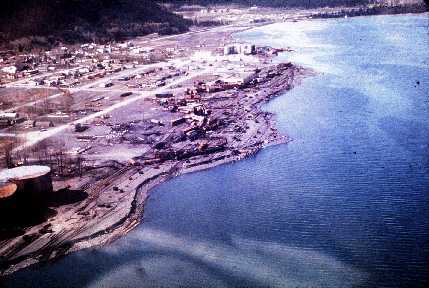 Photo from the Earth Science Photographs from the U.S. Geological Survey Library |
"The waterfront at Seward a few months after the earthquake, looking north. Note the 'scalloped' shoreline left by the underwater landslides that severed tracks in the railroad yard which dangle over the landslide scarp and the windrow-like heaps of railroad cars and other debris thrown up by the tsunami waves." [1] |
| Waves spread in all directions destroying the Alaska railroad docks, washing out railroad and highway bridges, and piling railroad rolling stock into giant windrows of wreckage. It spread flaming petroleum over the waterfront, igniting the rolling stock, the electrical generation plant, and some residences. |  |
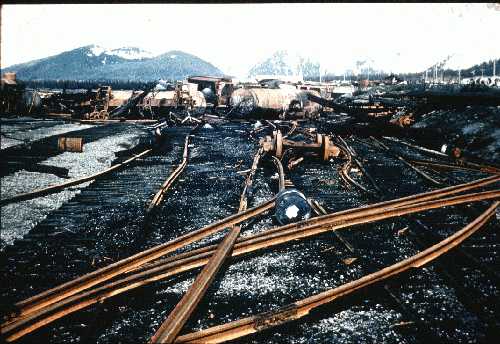
Photo by NOAA/NGDC |
Fire and water - the damage is done. |
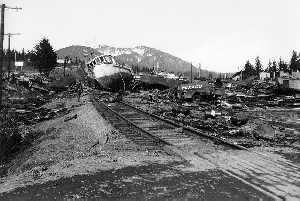 |
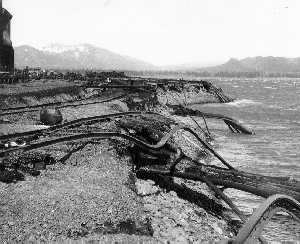 |
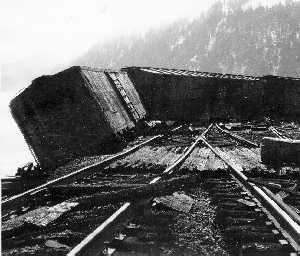 |
Photos courtesy of Tim Machin |
| "Salmon fishing enthusiasts from all parts of
the globe knew Seward the home of an annual Silver Salmon Derby. But Sewards
main claim to fame was its location as the southern end of the 470 mile
long Alaska Railroad. The railroad owned two docks at Seward, valued at
$4,000,000. In the ice-free harbor, oil and other valuable cargo was transferred
from ships to railroad cars. The railroad was the lifeline of Alaska that
cut deep into the heart of the state. On March 27th, this artery was severed
at its source. Seconds after the initial shock, waterfront sections slid
into Resurrection Bay. The Bay swallowed the two docks, a warehouse and
eight fuel storage tanks.
But the real horror was yet to come. Some oil tanks that had not disappeared into Resurrection Bay exploded. When the first big sea wave careened into the waterfront, it swept raging oil fires toward town. The returning gust of waves brought the flaming petroleum back into the bay. During this holocaust, fishing boats, tugs and tankers were washed ashore. Homes, cars and buildings swirled together in a hideous, flaming ride. Huge locomotives suddenly were flung like plastic toys into the center of Seward. The enormous waves attacked six times before retreating." [2] |
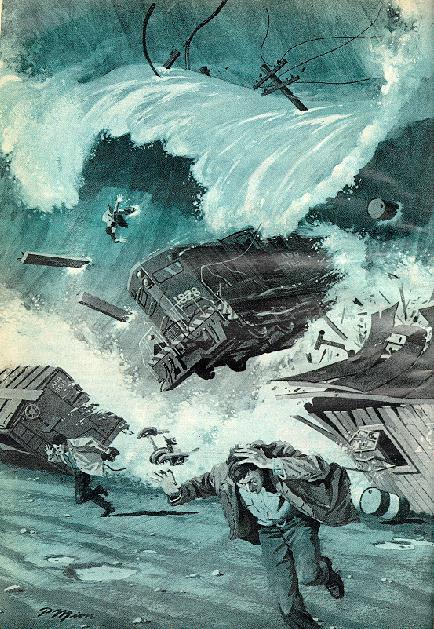
Drawing by Pierre Mion from December, 1971 "Popular Science". The image was painted from eyewitness accounts! |
 |
| Clara Elge says of her photo, "The box car sat
on the other side of the lagoon at the bottom of a cliff. It shows
as a light
spot on the photograph. Some 'Big money' homes were built on the top of the cliff and around the lagoon and after that the car disappeared. I think it was decided that it was an eye sore and a liability to the city also. I actually knew a couple who had lived in there one winter when they first came to Alaska back in the 1970's! I had a fit when we went to town one day and it was gone. I heard it was hauled to the dump and demolished. We used to show it to all of our out of town friends so they could imagine some of the power of the quake." [Webmaster note: When my wife and I visited Seward
in 1986, we stayed at a Bed and Breakfast (home). The owner
|
Had enough yet? If not, click here
for more ARR Seward destruction.
earthquake main | earthquake
story | information credits | ARR
main page
Page created 11/20/98 and last updated 6/15/10